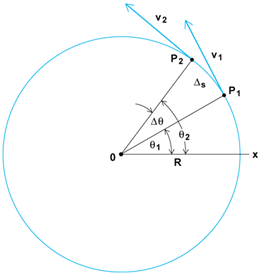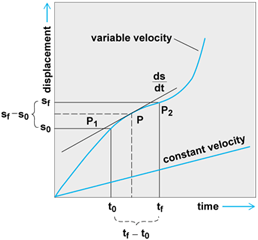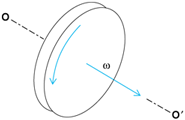Key Concepts
The time rate of change of position of a body in a particular direction. Velocity is a fundamental element of classical mechanics. Because both a magnitude and a direction (Fig. 1) are implied in a measurement of velocity, velocity is a directed or vector quantity, and to specify a given velocity completely, the direction must always be given. The magnitude only is called the speed. See also: Classical mechanics; Motion; Physics; Speed; Vector (mathematics)

Linear velocity
Linear velocity is velocity along a straight line, and its magnitude is commonly measured in such units as meters per second (m/s), feet per second (ft/s), and miles per hour (mi/h). A body need not move in a straight line path to possess linear velocity. The instantaneous velocity of any point of a body undergoing circular motion is a vector quantity, such as v1 or v2 in Fig. 2. When a body is constrained to move along a curved path (Fig. 3), it possesses at any point an instantaneous linear velocity in the direction of the tangent to the curve at that point. The average value of the linear velocity is defined as the ratio of the displacement to the elapsed time interval during which the displacement took place. The displacement of a body from an initial position s0 to a final position sf after time t is equal to sf − s0. The corresponding time interval is tf − t0. The magnitude of the average velocity is then given by Eq. (1),


where Δs is displacement and Δt is the corresponding elapsed time. See also: Circle; Time
The magnitude of the instantaneous velocity v of a body is the limiting value of the foregoing ratio as the interval approaches zero. In the notation of calculus, Eq. (2), ds/dt is the instantaneous time rate of change of displacement (Fig. 3).
The velocity of a body, like its position, can only be specified relative to a particular frame of reference. Consequently, all velocities are relative. See also: Relative motion
Angular velocity
Angular velocity is the rate at which a body revolves or rotates. The representation of angular velocity ω as a vector is shown in Fig. 4. The vector is taken along the axis of spin. Its length is proportional to the angular speed and its direction is that in which a right-hand screw would move. If a body rotates simultaneously about two or more rectangular axes, the resultant angular velocity is the vector sum of the individual angular velocities. Thus, if a body rotates about an x axis with angular velocity ωx, and simultaneously about a y axis with an angular velocity ωy, the resultant angular velocity ω is the vector sum given by Eq. (3).

It should be emphasized that whereas angular velocities are commutative in addition, that is, they may be added in any order, angular displacements are not commutative. See also: Rotational motion
Angular displacement
Figure 2 represents a body rotating with circular motion about an axis through O perpendicular to the figure. Line OP1 is the position of some radius in the body at a time t1, with θ1 being the angular displacement from a reference line. Line OP2 is the position of the same radius at a later time t2, with the angular displacement θ2. Angular displacement may be measured in degrees, radians, or revolutions.
Angular speed
From Fig. 2, it is seen that the body has rotated through the angle Δθ = θ2 − θ1 in the time Δt = t2 − t1. The average angular speed is defined by = Δθ/Δt, and the instantaneous angular speed ω = d θ/dt. Although it is customary in most scientific work to express angular speed in radians per second, it is common in engineering practice to use the units of revolutions per minute (rpm) or revolutions per second (rps).
Tangential velocity
When a particle rotates in a circular path of radius R through an angular distance Δθ in a time Δt, as in Fig. 2, it traverses a linear distance Δs. The average linear speed is given by Eq. (4),
since Δs = RΔθ. Similarly, the instantaneous speed v is given by v = ωR. The direction of this instantaneous speed is tangential to the circular path at the point in question. Any vector v drawn in this direction represents the tangential velocity.
Combined velocities
A body may have combined linear and angular motions, as is the case when the wheel of a moving automobile rolls along the ground with an angular velocity about its axle which moves with a linear velocity parallel to the pavement. In this case, a point on the rim of the tire describes a curved path called a cycloid. If a circular body rolls on the surface of a sphere, a point on the periphery of the rotating body describes a curve called an epicycloid. See also: Cycloid; Epicycloid





